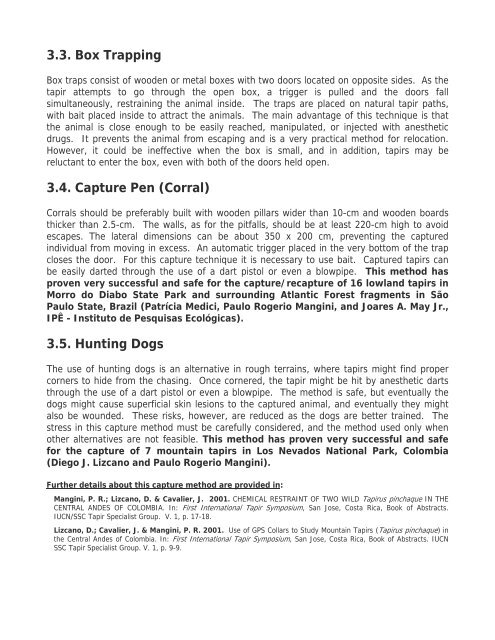TAPIR FIELD VETERINARY MANUAL - Tapir Specialist Group
TAPIR FIELD VETERINARY MANUAL - Tapir Specialist Group
TAPIR FIELD VETERINARY MANUAL - Tapir Specialist Group
Create successful ePaper yourself
Turn your PDF publications into a flip-book with our unique Google optimized e-Paper software.
3.3. Box Trapping<br />
Box traps consist of wooden or metal boxes with two doors located on opposite sides. As the<br />
tapir attempts to go through the open box, a trigger is pulled and the doors fall<br />
simultaneously, restraining the animal inside. The traps are placed on natural tapir paths,<br />
with bait placed inside to attract the animals. The main advantage of this technique is that<br />
the animal is close enough to be easily reached, manipulated, or injected with anesthetic<br />
drugs. It prevents the animal from escaping and is a very practical method for relocation.<br />
However, it could be ineffective when the box is small, and in addition, tapirs may be<br />
reluctant to enter the box, even with both of the doors held open.<br />
3.4. Capture Pen (Corral)<br />
Corrals should be preferably built with wooden pillars wider than 10-cm and wooden boards<br />
thicker than 2.5-cm. The walls, as for the pitfalls, should be at least 220-cm high to avoid<br />
escapes. The lateral dimensions can be about 350 x 200 cm, preventing the captured<br />
individual from moving in excess. An automatic trigger placed in the very bottom of the trap<br />
closes the door. For this capture technique it is necessary to use bait. Captured tapirs can<br />
be easily darted through the use of a dart pistol or even a blowpipe. This method has<br />
proven very successful and safe for the capture/recapture of 16 lowland tapirs in<br />
Morro do Diabo State Park and surrounding Atlantic Forest fragments in São<br />
Paulo State, Brazil (Patrícia Medici, Paulo Rogerio Mangini, and Joares A. May Jr.,<br />
IPÊ - Instituto de Pesquisas Ecológicas).<br />
3.5. Hunting Dogs<br />
The use of hunting dogs is an alternative in rough terrains, where tapirs might find proper<br />
corners to hide from the chasing. Once cornered, the tapir might be hit by anesthetic darts<br />
through the use of a dart pistol or even a blowpipe. The method is safe, but eventually the<br />
dogs might cause superficial skin lesions to the captured animal, and eventually they might<br />
also be wounded. These risks, however, are reduced as the dogs are better trained. The<br />
stress in this capture method must be carefully considered, and the method used only when<br />
other alternatives are not feasible. This method has proven very successful and safe<br />
for the capture of 7 mountain tapirs in Los Nevados National Park, Colombia<br />
(Diego J. Lizcano and Paulo Rogerio Mangini).<br />
Further details about this capture method are provided in:<br />
Mangini, P. R.; Lizcano, D. & Cavalier, J. 2001. CHEMICAL RESTRAINT OF TWO WILD <strong>Tapir</strong>us pinchaque IN THE<br />
CENTRAL ANDES OF COLOMBIA. In: First International <strong>Tapir</strong> Symposium, San Jose, Costa Rica, Book of Abstracts.<br />
IUCN/SSC <strong>Tapir</strong> <strong>Specialist</strong> <strong>Group</strong>. V. 1, p. 17-18.<br />
Lizcano, D.; Cavalier, J. & Mangini, P. R. 2001. Use of GPS Collars to Study Mountain <strong>Tapir</strong>s (<strong>Tapir</strong>us pinchaque) in<br />
the Central Andes of Colombia. In: First International <strong>Tapir</strong> Symposium, San Jose, Costa Rica, Book of Abstracts. IUCN<br />
SSC <strong>Tapir</strong> <strong>Specialist</strong> <strong>Group</strong>. V. 1, p. 9-9.










